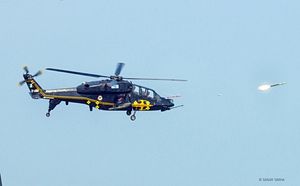Hindustan Aeronautics Limited’s (HAL) Light Combat Helicopter (LCH) has successfully conducted an air-to-air missile firing on a moving aerial target at a test range in Chandipur, Odisha, HAL said in a January 17 statement. The recent test firing marks the official completion of weapons trials and the readiness for operational induction by the Indian Air Force (IAF) and Indian Army (IA) of India’s first indigenously built and designed helicopter gunship.
The IAF test pilot “executed a flawless mission and achieved a direct hit on the aerial target, destroying it completely,” by firing a MBDA Mistral air-to-air missile, according to the statement. Mistral is a lightweight, fully heat-seeking missile with a maximum engagement range of 6.5 kilometers. According to the MBDA website, “Mistral missile system “is based on two launchers, each bearing two missiles, and can be connected to the helicopter’s combat system, when mounted on combat helicopters.”
The Indian Ministry of Defense (MoD) approved the procurement of 10 LCHs for the IAF and five for the Indian Army Air Corps (AAC) as part of a limited series production order in November 2016. While the AAC has committed to buying 114 LCHs, the IAF intends to induct 65 helicopters. Then-Indian Defense Minister Arun Jaitley officially kicked off full-scale production of the LCH at a HAL production facility in Bengaluru in August 2017. So far a total of four LCH prototypes have taken to the sky, with the first flight test taking place in May 2010.
The twin-engine 5.8-ton helicopter gunship features a narrow two-crew armored cockpit. “The LCH, a derivative of the HAL Dhruv helicopter, has been primarily designed for high-altitude warfare – HAL and French engine-maker, Turbomeca jointly designed a special engine optimized for extreme altitudes – and has an operational ceiling limit of 6,000–6,500 meters (19,700–21,300 feet),” I explained previously. Per-unit cost is estimated at $18-20 million.
As I reported back in 2017:
The LCHs armament includes a 20 millimeter French Giat-Nexter turret gun, four Belgium-made 70 mm anti-tank guided missiles (or, once operational, the Indian Helina anti-tank guided missile), and MBDA Mistral-2 air-to-air missiles. As of now, the Indian military lacks an anti-tank guided missile to arm the LCH with.
The helicopter’s advanced electronic warfare suite is supplied by SAAB South Africa, whereas the LCH’s modern sensor suite has been developed in cooperation with the Israeli defense industry. The gunship also features a data-link for network-centric operations.
Tests of the 20 millimeter turret gun and the 70 millimeter rockets were successfully completed in 2018. HAL noted in its January statement that the pilots will be equipped with state-of-the-art helmet-mounted sights, which enables them to fire missiles at a target merely by turning their head and looking at it. Using these sights, pilots can now launch a missile onto any target without having to turn the helicopter.
“The fire and forget missile is effective against all types of aerial threat, including UAVs and microlight aircraft,” the statement reads. “Capable of operating from dispersed locations and flying at ultra low levels, LCH can now effectively provide a protective umbrella from all aerial threats.”
































